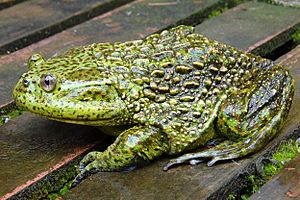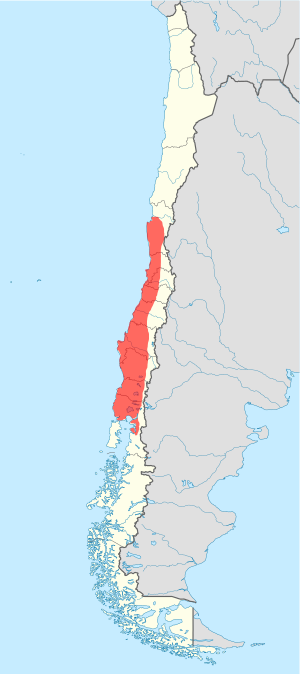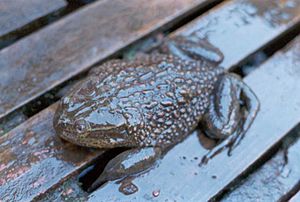Helmeted water toad facts for kids
Quick facts for kids Helmeted water toad |
|
|---|---|
 |
|
| Calyptocephalella gayi | |
| Conservation status | |
| Scientific classification | |
 |
|
| Range in red | |
| Synonyms | |
|
The Calyptocephalella is a type of frog found in the family Calyptocephalellidae. Only one living species exists today: Calyptocephalella gayi. It is often called the helmeted water toad, Chilean helmeted bull frog, or wide-mouthed toad.
Long ago, there were other kinds of these toads. We know about them from Late Cretaceous and Paleogene fossils. These fossils were found in Patagonia (South America) and the Antarctic Peninsula. Back then, these places were much warmer and wetter.
Today's helmeted water toad lives mostly in water. You can find it in deep ponds and reservoirs in central Chile. It might also live in nearby parts of west-central Argentina.
This very large toad usually weighs between 0.5 and 1 kilogram (1.1 to 2.2 pounds). Some can weigh even more! It is the second largest frog in the world, after the goliath frog. Sadly, this toad is in danger. People catch it for food, and its home is disappearing. Pollution, new animals, and a disease called chytridiomycosis also threaten it. Sometimes, people keep them as pets. They are also raised on farms for food, especially in Chile.
Contents
Amazing Features of the Helmeted Water Toad
The helmeted water toad is a strong frog with a wide head and a big mouth. It is very large! Males can grow up to 15.5 centimeters (6.1 inches) long from snout to tail. Females can reach an amazing 32 centimeters (12.6 inches) long.
Most of these toads weigh between 0.5 and 1 kilogram (1.1 to 2.2 pounds). But some very big ones have been recorded at 1.2 to 1.3 kilograms (2.6 to 2.9 pounds). It is the biggest frog or toad in all of the Americas. It is even bigger than other large species like the cane toad or the American bullfrog.
Its maximum length is similar to the world's largest frog, the African goliath frog. However, the goliath frog can weigh more. Helmeted water toads come in many colors. They can be yellow, brown, or green. Younger adults are often light green. Older toads might be gray, or have gray spots on a dark body.
Their tadpoles (baby frogs) are also very big. They usually grow over 10 centimeters (3.9 inches) long. Some can even reach 15 centimeters (5.9 inches)! They are typically olive-brown to dusky in color.
How They Live
Reproduction and Life Cycle
Helmeted water toads breed in the spring in the Southern Hemisphere. This is usually in September and October. During this time, male toads make calls to attract females. A female can lay a huge number of eggs, from 1,000 to 16,000! She lays them in shallow water that has lots of plants.
Even though many eggs don't hatch, one female can produce over 1,000 tadpoles. Tadpoles usually live for five months to a year. Some can even live for up to two years as tadpoles. For tadpoles to survive, there must be plants in the water. Moving water also helps by keeping the oxygen levels good.
Seasonal ponds that sometimes drain are important for hatching. These places have fewer animals that might eat the tadpoles. When it rains, tadpoles can move from small ponds to bigger bodies of water. This helps them survive and grow. Tadpoles like cooler areas of the water and protective plants. Young toads that have just changed from tadpoles can sometimes be seen on land. In zoos, these toads can breed when they are 2 years old. One female even bred until she was 24 years old!
How They Behave
The helmeted water toad can be quite aggressive. It has a special loud call it uses when it sees other toads of its kind. If they meet another toad, they might puff up their bodies. They also open their big mouths and might jump towards the other toad. They can act this way towards animals that might try to eat them, including humans. But sometimes, they just dive silently into the water to escape.
What Do They Eat?
When they are tadpoles, helmeted water toads eat plants and decaying bits of things. Adult toads eat almost any animal they can catch and swallow. This includes fish, insects, small birds, small mammals, and even other frogs. Sometimes, they even eat other helmeted water toads!
Protecting the Helmeted Water Toad
The helmeted water toad is a vulnerable species. This means it is at risk of disappearing. The main reasons are:
- People catching them for food (and sometimes for the pet trade).
- Their homes (habitat) are being destroyed.
- Pollution in the water.
- New animals brought into their areas, like trout and the African clawed frog.
- A disease called chytridiomycosis, caused by a fungus.
There are frog farms that raise these toads for food. But it takes three years for them to grow big enough to sell. These farms haven't been able to produce enough to meet the demand. Even though it's against the law in Chile, wild toads are still often sold for food. It's hard to control this illegal trade. If these toads are traded internationally, a special permit is needed. This is because they are listed on CITES Appendix III.
Helmeted water toads usually live in water that is about 10°C (50°F) in winter and 20°C (68°F) in summer. They can handle a bit more, but if the water gets to 25°C (77°F), more of them start to die. They cannot survive at all if the water is around 30°C (86°F) or warmer. Scientists think that many toads will disappear by the year 2100 because of global warming. In some places, water levels have dropped a lot. This is due to climate change (drought) and water being taken for farming. When this happens, many helmeted water toads have died.
Another big threat is the African clawed frog. This frog carries the chytrid fungus. This fungus can make native amphibians sick. The fungus gets into the toad's skin cells. This makes their skin hard and thick, which can cause them to suffocate and die. This fungus has caused many amphibian populations to decline around the world. It was first reported in Chile in 2009. The African clawed frog also competes with the helmeted water toad for food and space.
See also
 In Spanish: Rana chilena para niños
In Spanish: Rana chilena para niños
- Goliath frog (Conraua goliath) – the world's largest frog from Africa
- Lake Junin giant frog (Telmatobius macrostomus) – the world's largest exclusively aquatic frog from Peru



